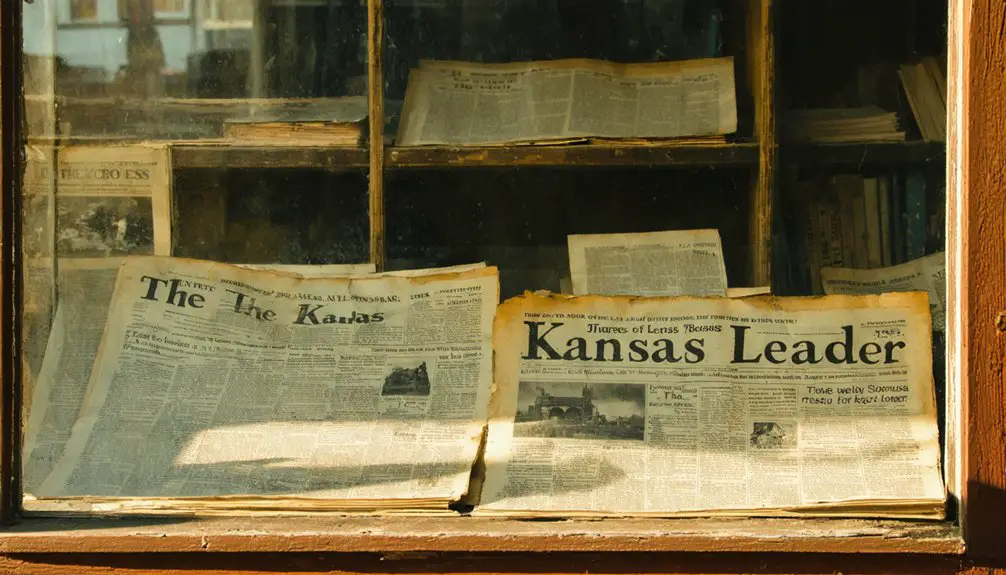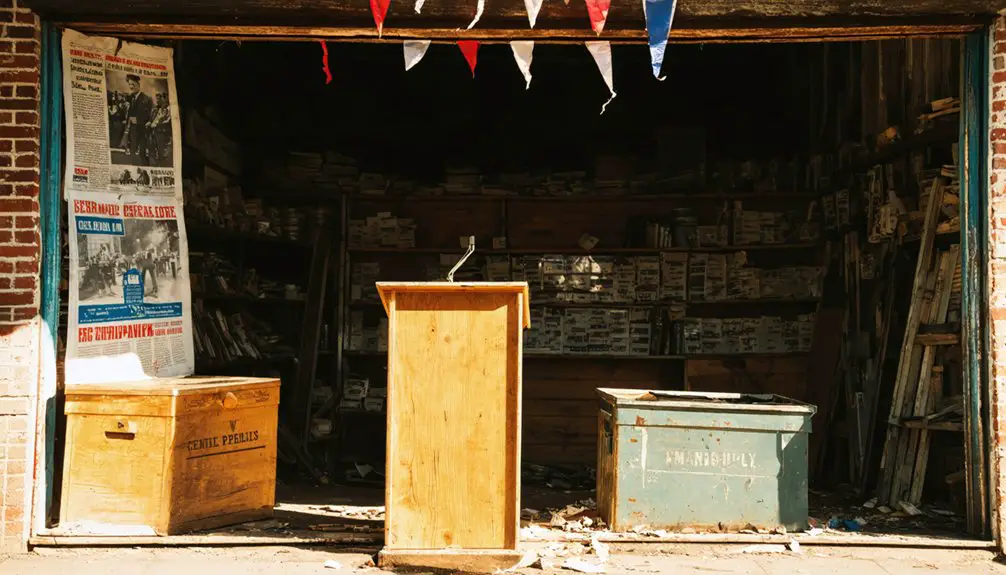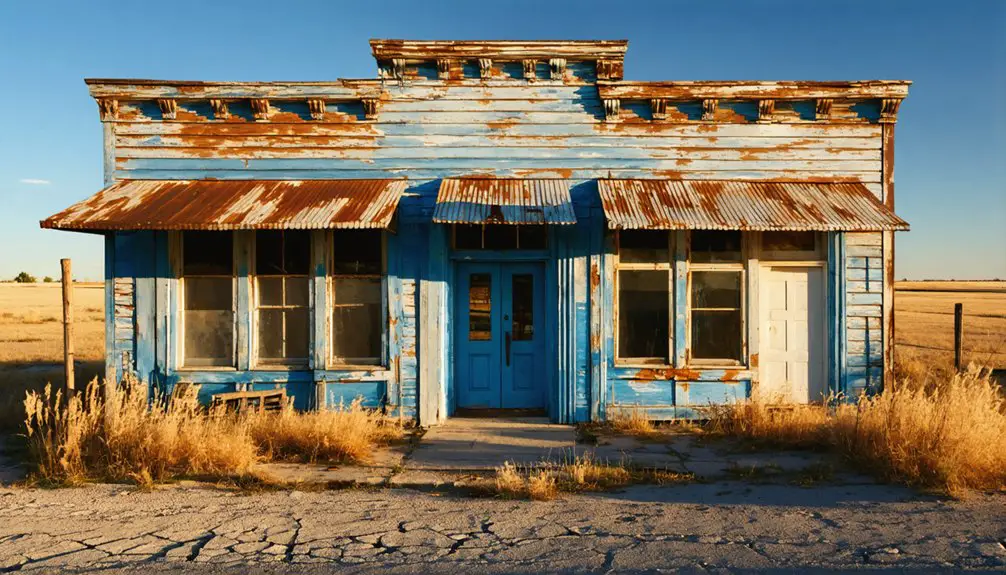You’ll discover Centropolis as one of Kansas’ forgotten frontier settlements, established in 1855 by Perry Fuller along Eight Mile Creek. This once-bustling trading post generated impressive annual sales of $50,000 and grew to thirty buildings by 1857. While competing with Minneola for territorial capital status, Centropolis ultimately declined, though its early architectural remnants and quiet rural landscape still tell tales of its ambitious past. The town’s connection to Kansas’ territorial history holds many surprising revelations.
Key Takeaways
- Founded in 1855 as a trading post, Centropolis declined after failing to secure territorial capital status against rival town Minneola.
- The closure of the post office marked a significant turning point in Centropolis’s transformation from thriving town to rural settlement.
- Despite early success with $50,000 annual trading post sales, lack of railroad access limited growth and contributed to the town’s decline.
- Early 20th-century buildings and original street layouts remain as physical evidence of the former town’s prosperous past.
- The once-bustling settlement now exists as a quiet rural community with scattered homes, churches, and predominantly agricultural activity.
The Birth of a Trading Post Settlement
While the Kansas Territory was still newly opened for settlement in 1855, Perry Fuller established what would become Centropolis by opening a trading post along Eight Mile Creek.
Perry Fuller pioneered Centropolis’s development in 1855, establishing a vital trading post on Eight Mile Creek in newly-settled Kansas Territory.
You’ll find that the trading dynamics centered on Fuller’s store, which quickly became a hub for commerce with nearby Ottawa Indians, generating impressive annual sales of $50,000.
The settlement challenges didn’t deter about fifteen pioneering settlers who claimed land that had just opened through a treaty with the Shawnee Indians. Similar to Cyprian Chouteau’s earlier trading post ventures in Kansas, these early residents, committed to Kansas joining the Union as a free state, saw Fuller partner with William Moore in 1856 to expand operations.
Together, they acquired their former suppliers West & James, strengthening Centropolis’s position as a crucial trading center in the region. The partners worked to establish the Centropolis Town Company with ambitious goals of becoming both the county seat and Territorial capital.
Perry Fuller’s Grand Vision
After establishing his successful trading post in 1855, Perry Fuller revealed an ambitious vision to transform Centropolis from a modest settlement into the future capital of Kansas Territory. His store’s impressive $50,000 annual sales fueled Fuller’s aspirations for something greater.
In 1856, Fuller partnered with influential figures like Cyrus K. Holliday to form the Centropolis Town Company. You’d have witnessed rapid development as they sold premium lots for $500 each, attracting diverse businesses from hotels to saloons.
The Kansas Leader newspaper strengthened Centropolis’ identity as a cultural hub. By 1857, the bustling town boasted thirty completed buildings.
Fuller’s dual role as entrepreneur and territorial politician showcased his determination to shape Kansas’s future. Despite the negative impact of his liquor trade with local tribes, his vision laid the foundation for a thriving commercial center. The town maintained an active post office until 1930, serving as a vital communication hub for the region.
Political Rivalry With Minneola
As you explore Centropolis’s history, you’ll find its most dramatic chapter in the fierce rivalry with nearby Minneola for territorial capital status.
Due to multiple interpretations of Minneola’s history and significance, some details of the rivalry remain debated by historians.
The two towns embodied opposing sides of the slavery debate, with Centropolis’s pro-slavery reputation clashing against Minneola’s Free-State alignment during the volatile 1850s.
When the territorial legislature convened in Lawrence in 1857 to choose a new capital location, the political maneuvering between these competing settlements highlighted the broader tensions of “Bleeding Kansas.” Perry Fuller and his associates ultimately secured a legislative vote making Minneola the capital through bribery, though this decision was later vetoed.
Capital Status Battle
The battle for territorial capital status between Centropolis and Minneola emerged during Kansas’s tumultuous pre-statehood period.
These rival towns’ capital ambitions reflected the broader struggle for territorial identity, with both communities vying for political prominence and economic growth. The emerging Free-State political party played a significant role in shaping the territorial capital debate.
Perry Fuller and his associates purchased 14 quarter sections near Minneola to strengthen its bid.
The Kansas Leader newspaper relocated from Centropolis to Minneola, becoming the Minneola Statesman.
The legislature met in Lawrence to decide the capital’s fate, moving away from pro-slavery Lecompton.
Despite their fierce competition and strategic maneuvering, neither town achieved its goal of becoming Kansas’s territorial capital, ultimately leading to their decline into ghost town status.
Political Factions Collide
Political tensions between Centropolis and Minneola erupted when Perry Fuller, a territorial senator and prominent businessman, established Minneola across Eight Mile Creek in direct competition with his former base of operations.
You’ll find the rivalry was deeply rooted in the territory’s political alliances, with Minneola’s founders acquiring extensive farmland to strengthen their bid for capital status.
The battle played out prominently in local media, as the Kansas Leader switched allegiance to become the Minneola Statesman, reflecting the shift in political power.
Economic rivalries intensified when the Free-State government rejected Centropolis due to its pro-slavery associations.
Fuller’s controversial business practices, including selling liquor to Native Americans, had tarnished Centropolis’s reputation, ultimately influencing the territorial legislature’s decisions on the capital’s location.
Territorial Legislature Maneuvers
Following the Free-State voters’ triumph over pro-slavery forces in 1857, legislative maneuvers to relocate Kansas’s territorial capital from Lecompton intensified into a fierce competition between Centropolis and Minneola.
You’ll find that Perry Fuller’s legislative strategy proved decisive in this rivalry. As both a territorial senator and businessman, he orchestrated an ambitious political lobbying campaign that included:
- Purchasing 14 quarter sections near Minneola for speculation
- Distributing free town lots to gain legislative support
- Relocating the Kansas Leader newspaper to promote Minneola
While Fuller successfully secured Minneola’s selection as the new territorial capital, his victory was hollow. The hastily constructed capitol building never hosted a single legislative session, and public outrage over perceived corruption ultimately doomed both towns’ metropolitan aspirations. Fuller’s initial presence in the area began when he established a store to trade with the Ottawa Indians in 1855.
The Kansas Leader Newspaper Legacy

The Kansas Leader’s 1857 establishment as Franklin County’s first commercial newspaper marked a pivotal moment in the region’s development.
You’ll find the paper’s archives reveal detailed coverage of territorial politics, local commerce, and social events that shaped early Kansas settlement patterns.
The Leader’s eventual move to Minneola reflected the shifting fortunes of Centropolis while preserving its legacy as a pioneer in Kansas journalism. Joel K. Goodin, who named the town with aspirations of it becoming the territorial capital, was instrumental in establishing the newspaper’s presence.
Historical Publishing Impact
As a cornerstone of Franklin County’s early media landscape, the Kansas Leader newspaper emerged in fall 1956 under publishers W.H. Austin and Beardsley. This pioneering venture in local journalism transformed how Centropolis residents stayed informed and engaged with their community during a critical period of change.
The paper’s impact on the region was significant in several ways:
- It documented the town’s evolution from Native American reservations to settler communities.
- You’d find coverage of essential infrastructure developments, including the groundbreaking Centropolis Telephone Company. Similar to how mandatory drug testing became a vital requirement for safety-sensitive positions in later decades, the newspaper served as a critical compliance tool for the community.
- The publication strengthened community bonds by sharing local news, events, and promoting civic participation.
As Franklin County’s first town newspaper, the Kansas Leader established a template for small-town publishing that would influence journalism throughout Kansas, demonstrating how local news could unite and inform rural communities.
First Countywide News Coverage
When W.H. Austin established The Kansas Leader in Centropolis during fall 1956, you’d have witnessed a groundbreaking moment in local journalism. As Franklin County’s first extensive newspaper, it filled an essential void in community engagement that had existed since the region’s settlement in the 1850s.
The Leader transformed how you’d get your news, serving as the primary source for county-wide information when telephone services were still basic and manually operated. From weekly updates on local governance to agricultural developments, the paper kept you connected to significant community happenings.
This pioneering publication adapted to the technological constraints of rural Kansas while maintaining consistent coverage of events that mattered to your daily life, creating an enduring legacy in Franklin County’s historical record.
Early Trade and Commerce Growth
During Centropolis’s formative years, Perry Fuller established the settlement’s first trading post in 1855, marking the beginning of organized commerce in the area. The trade dynamics centered around exchanges with local tribes like the Shawnee, Sac and Fox, Chippewa, and Ottawa, generating impressive annual sales of $50,000 by the mid-1850s.
Early commerce flourished as the Centropolis Town Company formed in 1856, bringing rapid development:
- Fuller’s store served as a crucial hub, trading frontier supplies for Native American furs
- The sawmill’s construction in 1857 supported the town’s infrastructure growth
- A boarding house and restaurant emerged to serve the growing community
Despite the promising start and substantial investments, including $500 lots, the lack of railroad access would eventually limit Centropolis’s economic expansion and long-term growth potential.
The Rise and Fall of Political Ambitions

From its inception in 1855, Centropolis embodied Perry Fuller‘s grand political vision of establishing Kansas Territory’s capital city.
Through the Centropolis Town Company, Fuller strategically positioned the settlement as a future powerhouse in territorial politics, bolstered by successful trade with Native American tribes.
The community dynamics quickly became entangled in the era’s intense territorial struggles between pro-slavery and free-state factions.
You’ll find that Centropolis faced fierce competition from rival towns like Minneola and St. Bernard.
Fuller’s political ambitions suffered a critical blow when the territorial legislature rejected Centropolis as the capital, partly due to its pro-slavery associations.
Even Fuller’s newspaper, the Kansas Leader, couldn’t salvage the town’s political aspirations, and when he shifted his focus to Minneola, Centropolis’s dream of becoming a political center faded.
Life in Early Centropolis
If you’d visited Centropolis in its early days, you’d have found Perry Fuller’s bustling trading post serving both settlers and Ottawa Indians with essential goods and supplies.
The town quickly developed into a vibrant pioneer community, featuring multiple businesses including grocery stores, hotels, livery stables, and four saloons that catered to locals and travelers alike.
The establishment of these diverse services, along with property lots selling for up to $500, reflected the town’s promising economic growth and its role as a significant trading hub in Franklin County.
Trading Post Activities
The heart of early Centropolis began beating in 1855 when Perry Fuller established the town’s first trading post, a venture that would shape the community’s economic foundation.
Fuller’s trading strategies proved successful, generating an impressive $50,000 in annual sales through robust indigenous relations and settler commerce.
You’ll find that Fuller’s entrepreneurial spirit led to three key developments:
- Partnership with William Moore in 1856, expanding business operations
- Acquisition of their supplier, West & James of Kansas City
- Creation of a crucial hub for both Native American and settler trading
This thriving post became more than just a store – it was the cornerstone of early Centropolis’s growth, providing essential goods and fostering relationships between diverse communities in the region.
Pioneer Community Development
Beyond Fuller’s trading post, vibrant pioneer life took root in Centropolis Township during June 1854, when fifteen determined settlers staked their claims along Eight Mile Creek.
The pioneer spirit emerged immediately as these settlers cast their votes about Kansas’s future, with most supporting a free state. Their community aspirations soared high, as they envisioned Centropolis becoming both county seat and state capital.
You’ll find the town quickly transformed through the determined efforts of its residents. By 1856, they’d established a proper town company and built essential businesses including grocery stores, hotels, and a sawmill.
The Kansas Leader newspaper began publishing in 1857, while education took hold with William Cator teaching the first classes in 1855.
Though the town peaked early, these developments showcase the remarkable drive of Kansas’s early settlers.
Post Office Closure and Community Changes

During Centropolis’s gradual decline, its post office closure marked a significant turning point for the community’s identity and daily operations. You’d find the post office impact reached far beyond just mail delivery, as it served as the town’s crucial communication hub since its early settlement days.
The closure process, governed by federal regulations, required extensive notification periods and offered appeal options through the Postal Regulatory Commission.
Federal mandates ensured communities had clear notice and recourse when facing post office closures through the Postal Regulatory Commission’s oversight.
The community faced several significant changes:
- Loss of essential services including passport processing, mail pickup, and business operations
- Increased travel burden as residents now relied on neighboring towns for postal needs
- Diminished community connectivity, accelerating the town’s isolation and population decline
This closure reflected broader trends in rural Kansas, where consolidation of postal services mirrored the community’s declining population and economic challenges.
Modern Day Ghost Town Status
While Centropolis bears the designation of a ghost town, its modern reality presents a more nuanced picture with roughly 100 residents still calling it home as of 2020.
You’ll find community resilience in the active churches and scattered homes that dot the landscape, even as the town’s commercial heart has largely ceased beating.
The physical remnants of Centropolis’s past are still visible in its early 20th-century architecture and street layouts, stirring rural nostalgia among visitors and locals alike.
Though you won’t find an operational post office or thriving business district, the remaining structures tell stories of the town’s more prosperous days.
Today’s Centropolis functions more as a quiet rural settlement, where agriculture dominates the surrounding landscape and residents maintain a modest but persistent community presence.
Historical Significance in Franklin County
The rich history of Centropolis stretches back to 1855, marking it as Franklin County’s pioneering settlement. You’ll find its heritage deeply woven into the territorial ambitions that shaped Kansas, starting with Perry Fuller’s trading post that established essential commerce with local tribes.
The early settlers’ dreams of territorial prominence sparked intense community dynamics that would define the region’s political landscape.
- Centropolis flourished as Franklin County’s commercial hub, boasting the area’s first newspaper and diverse businesses that shaped the social fabric.
- The town’s historical rivalry with Minneola exemplifies the fierce competition for territorial capital status.
- Despite losing the capital bid, Centropolis’s commerce evolution set early standards for frontier development and demonstrated the entrepreneurial spirit of Kansas Territory.
Frequently Asked Questions
What Happened to Perry Fuller After Centropolis Failed to Become the Capital?
Like a pioneer chasing the setting sun, you’ll find Perry Fuller founded Minneola across Eight Mile Creek, relocating his newspaper there and renaming it the Minneola Statesman to compete with his former town.
Are There Any Descendants of Original Centropolis Settlers Still Living There?
Based on available descendant stories and family histories, you won’t find confirmed descendants of original settlers living in Centropolis today. The aging population and town’s ghost status suggest most families moved away.
What Native American Artifacts Have Been Discovered in the Centropolis Area?
You’ll find stone tools, flint fragments, pottery shards, and projectile points among the Native artifacts discovered, though there’s less documented cultural significance compared to nearby Arkansas City’s extensive archaeological findings.
Did Centropolis Have Any Notable Outlaw Activity During Its Early Years?
You won’t find documented outlaw legends or significant criminal activities in Centropolis’ early history. While nearby towns experienced notable encounters with outlaws, Centropolis maintained a relatively quiet existence.
Were There Any Major Natural Disasters That Contributed to Centropolis’s Decline?
Unlike a devastating storm, nature wasn’t your town’s downfall. You won’t find records of significant flood damage or drought impact that directly contributed to Centropolis’s decline during its history.
References
- https://en.wikipedia.org/wiki/Minneola
- https://www.kancoll.org/articles/progress/minneola.htm
- https://en.wikipedia.org/wiki/Centropolis
- https://legendsofkansas.com/franklin-county-extinct-towns/
- https://legendsofkansas.com/kansas-ghost-town-list/
- http://www.kancoll.org/books/cutler/franklin/franklin-co-p10.html
- https://legendsofkansas.com/trading-post-kansas/
- http://www.kancoll.org/books/cutler/franklin/franklin-co-p2.html
- http://rcmahq.nwark.com/cent.htm
- https://www.franklincokshistory.org/wp-content/uploads/2012/07/Perry-Fuller-talk.pdf



